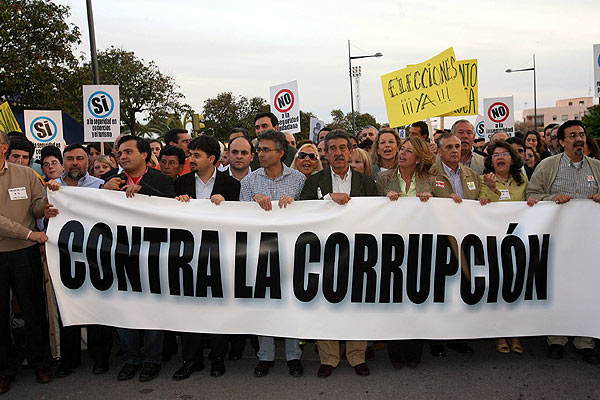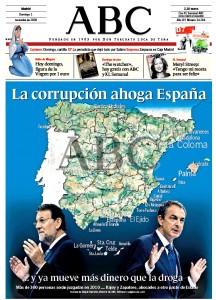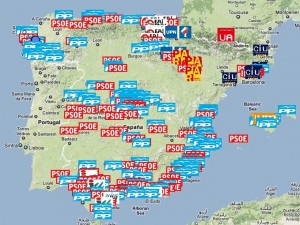Why Corruption Reigns in Spain
Hardly a week goes by without news of another high-profile corruption scandal in Spain. Several theories seek to explain the phenomenon.
Why Corruption Reigns in Spain
Soeren Kern | PJ Media | July 13, 2011
Hardly a week goes by without news of another high-profile corruption scandal in Spain. Several theories seek to explain the phenomenon.
More than 85 percent of Spaniards believe corruption in Spain is “very widespread” or “fairly widespread,” according to a new opinion poll conducted by the Madrid-based Sociological Research Center (CIS), an agency that provides the Spanish government with polling data. Only 0.2 percent of those polled believe corruption is “not widespread” in Spain.
More surprising (or maybe not) is the poll’s finding that most Spaniards view their fellow countrymen as relatively ambivalent about the corruption in Spain. Of those polled, 41.5 percent say Spaniards are “fairly tolerant” and 20 percent say they are “very tolerant” of corruption in Spain. More than 50 percent of those surveyed say Spaniards “almost never” or “never” obey the law.
Sixty percent of Spaniards say corruption is just a “part of human nature” and more than one-third believe it is “part of Spanish culture.” More than 85 percent of Spaniards say corruption exists because the government allows it; only 9.3 percent believe citizens have a responsibility to fight against it.
The poll comes amid news of yet another high-profile corruption scandal in Spain. On July 1, Spanish police raided the offices of the Society of Authors and Publishers (SGAE), Spain’s leading collection agency for songwriters and composers, and arrested nine senior officials suspected of embezzling up to €400 million ($575 million) in royalties that should have been distributed to musicians and record companies.
One of the largest corruption scandals in Spanish history, the Caso Malaya, involves 95 municipal officials in southern Spain who are accused of taking more than €2 billion ($3 billion) in bribes in exchange for building permits and/or contracts to run municipal services in the glitzy resort town of Marbella. The case, which is truly mindboggling in scale and scope, has spawned dozens of other investigations into corruption on the Costa del Sol.
Another ongoing corruption scandal is the Caso Gürtel involving Francisco Correa (Correa means Belt in English or Gürtel in German), a businessman who paid millions in bribes (in the form of cash, luxury cars, designer clothing, Caribbean holidays and lavish parties with prostitutes) to dozens of municipal officials and regional politicians, in exchange for building permits and contracts in Valencia, Madrid, Galicia and Castilla-León. Correa is suspected of accumulating a secret fortune worth at least €50 million ($70 million); he has not declared any income to the tax office since 1999.
The investigation into Correa and his network was launched by Spain’s so-called ‘Super-Judge’ Baltasar Garzón, but he himself has since been fired for abuse of power and for failing to declare more than $200,000 in earnings from the Spanish tax authorities.
Other high-profile corruption cases in Spain abound: Caso Millet, involving the diversion of €35 million from the Palau de la Mùsica in Barcelona; Caso Palma Arena, involving 30 defendants accused of misappropriating tens of millions of euros linked to construction of a €100 million indoor sports stadium in Palma de Mallorca; Caso Pretoria, involving 20 defendants accused of receiving millions of euros in bribes in exchange for building permits in Catalonia.
Still other cases include: Caso Arona, Caso Baeza, Caso Can Domengue, Caso Castellón, Caso Ceclavín, Caso Ciudad Real, Caso de los EREs, Caso de Miguel, Caso El Rosario, Caso Faycán, Caso Granadilla, Caso Guisando, Caso Ibiza, Caso La Gomera, Caso Las Navas del Marqués, Caso Llucmajor, Caso Loja, Caso Martina Gelabert, Caso Mercasevilla, Caso Muxia, Caso Ocaña, Caso Ohanes, Caso Pájara, Caso Palma Arena, Caso Sevilla, Caso Salares, Caso Son Oms, Caso Sotohenar, Caso Torrejón de Ardoz, Caso Tudela de Duero, Caso Villanueva de Gómez, Caso Villanueva de la Cañada, Caso Vipasa and Caso Zambrana.
Recent corruption-related police raids include: Operación Arcos, Operación Brisán, Operación Brugal, Operación Citur, Operación Costurero, Operación Harrag, Operación Molinos, Operación Orquesta, Operación Palmera, Operación Tequila, Operación Tótem, Operación Troya and Operación Unión, among many others.
Overall, Spain’s Ministry of Justice is currently investigating more than 700 cases of high-level corruption involving politicians from both major parties in all of the country’s 48 provinces. This includes 264 cases involving Socialists, 200 involving Conservatives, and hundreds more involving smaller regional parties. (See here for a map of corruption in Spain according to political party.)
After it emerged that more than 100 Socialist and Conservative politicians were running for re-election in municipal elections in May 2011 who were simultaneously under investigation for corruption, the head of the Socialist Party flippantly declared that corrupt Socialists were less corrupt than corrupt Conservatives.
One essay summed it up: “Being a corrupt politician in Spain is the safest criminal job there is. It is much safer than robbing banks or stealing handbags from old ladies. This country has invented the most effective system of impunity that is known in the galaxy, based on the motto ‘and you are more corrupt.’ Each party takes the view that their corrupt politicians are less corrupt than those of other parties and for that reason their corruption is the most beneficial.”
Spain has dropped five positions in the annual Corruption Perception’s Index produced by the Berlin-based Transparency International. Spain ranked number 30 in 2010, down from number 25 in 2005. Bribery, money laundering and tax fraud have cost Spain at least €4.2 billion ($6 bilion) over the past ten years, according to calculations by the center-right El Mundo newspaper, which calculated the figure based on court records and investigations of just 28 of the biggest corruption cases.
Spanish newspapers have been chock full of articles reflecting on Spain’s propensity for corruption: ‘Corruption in Spain: A Grave Problem for the Loss of Foreign Investment,’ ‘The Corruption Ballot,’ ‘The Map of Socialist Shame in Extremadura,’ ‘New Form of Corruption: Keep the Money of Fake Retirees,’ and ‘Why is There so Much Corruption in Spain?’
International media have also published stories on the phenomenon: ‘Why is Spain so Corrupt?,’ ‘Scandal Sullies Spain’s Clean Energy,’ ‘Spain Sees Endless Season for Political Scandal,’ ‘Spain: The Rise of Eco-Corruption?,’ ‘Corruption Widespread in Spanish Universities,’ and ‘Corruption in Spain: Shady Deals in the Sun.’
From these analyses, it is possible to discern a number of theories (structural, cultural and/or historical) try to explain the prevalence of corruption in Spain:
The ‘Opportunity’ Theory: This structural theory posits that a decades-long construction boom created unprecedented opportunities for corruption in Spain. As local governments issued building permits and authorized changes in land use from rural to urban development, they created huge profits for property developers as well as for municipalities. Taking this theory one step further, local bureaucrats on fixed salaries were able to leverage their power vis-à-vis cash-rich property developers to demand bribes in exchange for approving and fast-tracking building permits.
The ‘Incentives’ Theory: This structural theory posits that Spain’s notorious bureaucracy creates added incentives for corruption: the more red tape involved in doing business, the greater the likelihood that a bureaucrat will demand a bribe and/or the more incentive there is to pay for “short-cuts.” In other words: the bigger the government, the greater potential for abuse.
The ‘Transparency’ Theory: This structural theory posits that the lack of transparency in Spanish government institutions and decision-making increases the likelihood for corruption because the chances of getting caught taking a bribe are relatively low. When combined with lax law enforcement and weak punishments, corruption becomes more commonplace.
The ‘Regionalism’ Theory: This structural/historical theory posits that after the death of General Francisco Franco in 1975 and the end of his 40-year dictatorship, Spain’s fledgling democracy devolved considerable power back to the regions. In the post-Franco period, national parties have been highly dependent on coalitions with regional parties in order to govern. This has encouraged a certain “hands-off” policy of non-intervention by the central government in local/regional affairs. This in turn has cemented a system of clientelism into the fiber of regions like Andalucía and Extremadura, which have been ruled by the Socialist Party for more than three decades.
The ‘Allegiance’ Theory: This cultural theory posits that in Spain and other southern European countries where corruption is rife, people often look after the immediate and extended family before the greater good of society as a whole. This “me first” attitude incentivizes corruption at the most basic level of social organization, whether it be family, village, town, city, province and/or region.
The ‘Religion’ Theory: This cultural theory posits that as a works-based religion, Roman Catholicism facilitates corruption in countries (like Spain) where it dominates because it is easy to sin and be forgiven. According to this theory, the act of confession to a priest and doing penance (simply reciting a mantra of Hail Mary’s) enables wrongdoers to balance their sins with good deeds. This is in contrast to Protestant theology, where sinners are held directly accountable to God Himself. Many analysts also point to a connection between Roman Catholicism and clientelism in Spain.
The ‘Revenge’ Theory: This cultural/historical theory posits that corruption is a habit that was revived during the Franco dictatorship when thwarting the state was an act of resistance. Others say that after Franco died, Spain entered into a period of 14 years (1982-1996) of uninterrupted socialism when people took “revenge” against the dictatorship by “reclaiming” what was “stolen” from them.
Which theory is best? Most observers of Spanish politics would probably agree that corruption in the country can be best explained by a combination of all the theories. The big unanswered question is: With Spain on the brink of financial collapse, how much longer will Spaniards tolerate the corruption that is draining the national economy and society and holding the country back.
Soeren Kern is Senior Fellow for Transatlantic Relations at the Madrid-based Grupo de Estudios Estratégicos / Strategic Studies Group. Follow him on Facebook.
Originally published by Pajamas Media on July 13, 2011






